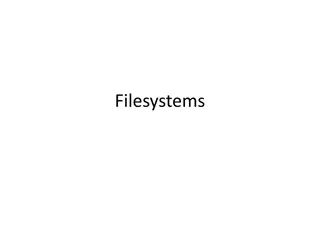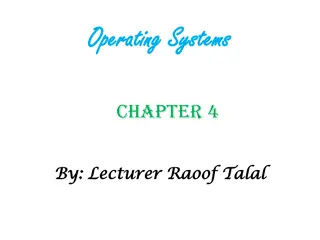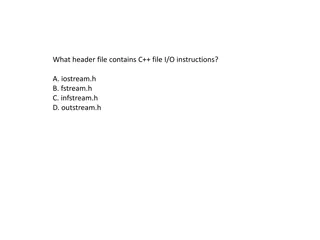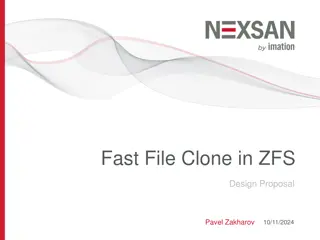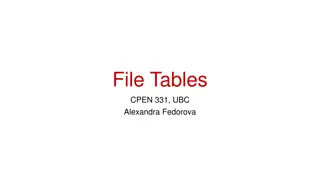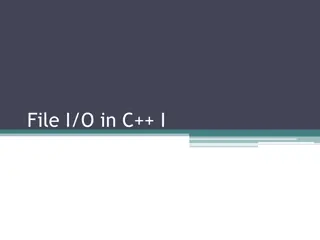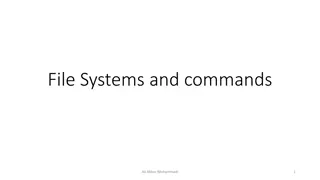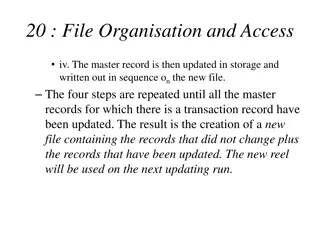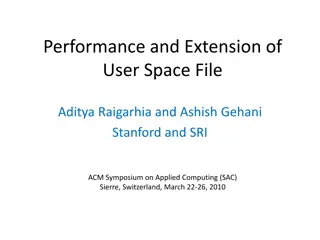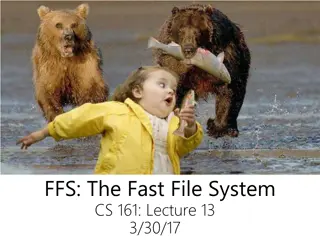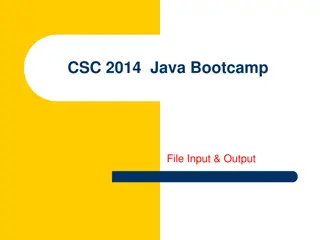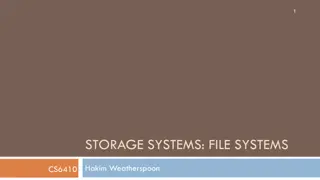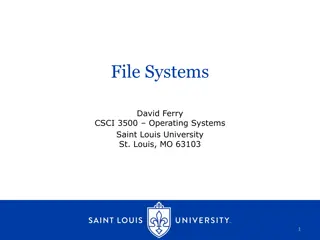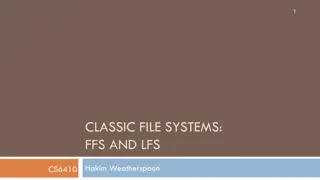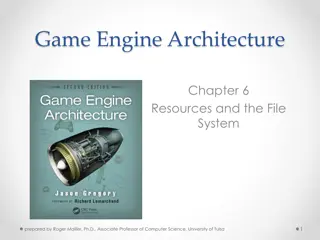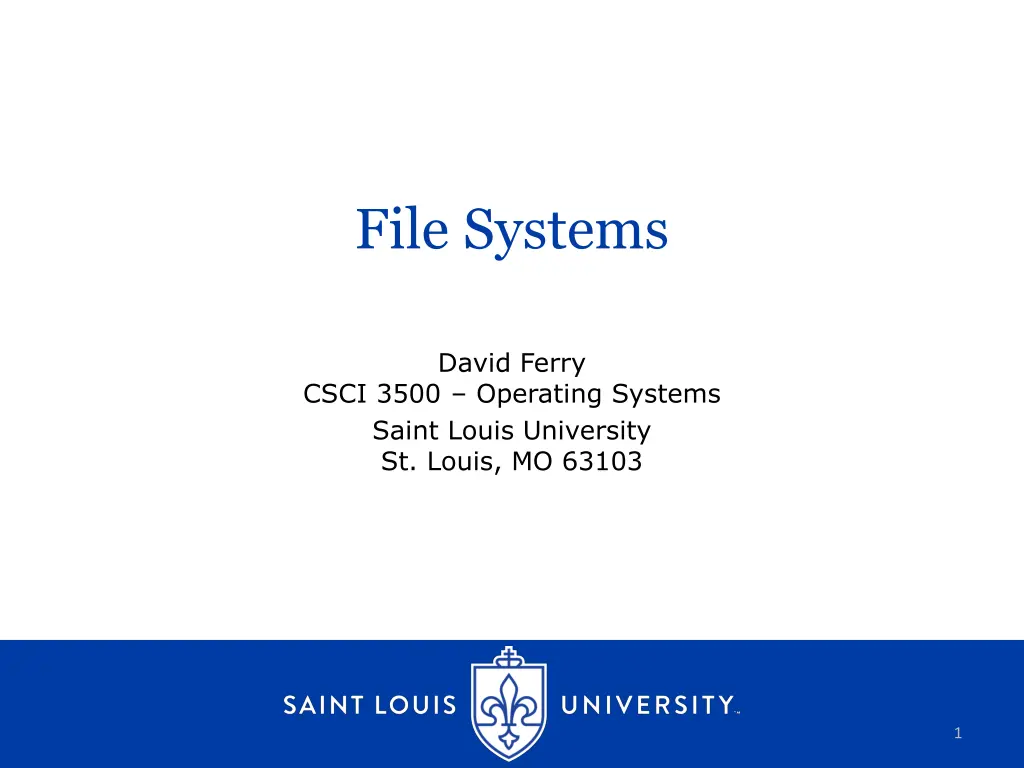
Understanding File System Fragmentation
Dive into the complexities of file system fragmentation, from the translation of variable-sized files to blocks to the evolution of allocation techniques like contiguous and linked list allocation. Explore the challenges and benefits associated with different strategies for managing file storage efficiently.
Download Presentation

Please find below an Image/Link to download the presentation.
The content on the website is provided AS IS for your information and personal use only. It may not be sold, licensed, or shared on other websites without obtaining consent from the author. If you encounter any issues during the download, it is possible that the publisher has removed the file from their server.
You are allowed to download the files provided on this website for personal or commercial use, subject to the condition that they are used lawfully. All files are the property of their respective owners.
The content on the website is provided AS IS for your information and personal use only. It may not be sold, licensed, or shared on other websites without obtaining consent from the author.
E N D
Presentation Transcript
File Systems David Ferry CSCI 3500 Operating Systems Saint Louis University St. Louis, MO 63103 1
Recall - Disks A disk (flash drive, etc.) is a large contiguous array of blocks: 512 bytes Q: How does the file system translate a variable-sized file into a collection of blocks? Q: How are the read() and write() operations supported? CSCI 3500 - Operating Systems 2
Contiguous Allocation Again! Recall contiguous allocation of memory. A A A B B C C C File A File B File C Filesystem associates each file name with a starting block and a file length, stored in some efficient data structure. + High throughput Need to specify size of file at creation time Hard to modify file size Fragmentation Still used in things like CD/DVD ROMs CSCI 3500 - Operating Systems 3
First Notion of Fragmentation Under contiguous allocation there can be little holes on the disk that are only one or two blocks long as there were with contiguous allocation of process memory. You could have many free blocks and a lot of free space on the drive, but if it s all tied up in little holes we couldn t allocate a large file. These are less problematic than our holes from memory allocation, because they can t be arbitrarily small. A A A B B C C C File A File B File C Hard to use hole CSCI 3500 - Operating Systems 4
Second Notion of Fragmentation Traditional notion: when a file is not contiguous on the drive and split into pieces Hard drive seek time takes a non-negligible amount of time. Having files all together means fewer read head movements. SSDs still suffer from fragmentation, but to a much lesser degree. There is OS and device overhead in having many small I/O operations vs a few large ones. E.g. 3,500 MB/s sequential read vs 900 MB/s random read on a recent SSD review
Linked List Allocation Contiguous allocation suffered from: Couldn t use small holes effectively Couldn t resize files effectively Let s drop the requirement that files are contiguous on disk OS stores a pointer to the first block of a file Each block in the file stores a pointer to the next block + Holes don t matter (remember fixed block size) + Files can grow or shrink Need to seek to find the next block => Slow, esp. seeking large files 3 2 4 1 File Start NULL CSCI 3500 - Operating Systems 6
FAT File Allocation Table Can we have the flexibility of linked list allocation without having to seek through blocks of the hard drive to find data? Soln: Store list structure in a table, not as a chain of pointers FAT NULL 0 File Start 1 5 3 2 4 1 2 0 1 2 3 4 5 6 3 1 4 -1 OS still needs to store the starting block of each file No need to seek through list poiners to find blocks However, now we must maintain this data structure FAT size scales linearly with size of disks 5 File Start 6 3 CSCI 3500 - Operating Systems 7
FAT Size Q: How many entries are needed in the FAT? A: One per block on the storage drive. Q: How big is an entry in the FAT? A: Big enough to address every block on the device. For example, a 1GB disk with 1KB blocks: Number of blocks = 230 / 210 = 220 blocks = 220 FAT entries Bits per entry = 20 or 2.5 bytes per block Size of FAT = 220 * 2.5 bytes = 2.5 megabytes CSCI 3500 - Operating Systems 8
FAT Size 2 Not bad for a 1GB disk, what about a 1TB disk? For example, a 1TB disk with 1KB blocks: Number of blocks = 240 / 210 = 230 blocks = 230 FAT entries Bits per entry = 30 or 3.75 bytes per block Size of FAT = 230 * 3.75 bytes = 3.75 gigabytes All of which needs to be stored on disk and stay in RAM for efficient operation. For this reason the FAT approach is not used for large disks today- generally the limit is 32GB. CSCI 3500 - Operating Systems 9
Indexing Large Drives - inodes Linked list allocation is extensible, and FAT allocation is efficient: how can we get both attributes at once? An inode is a collection of pointers Some are pointers to file data Some are pointers to other pointers inode Data Block Ptr 1 Data Block Ptr 2 Data Block Ptr 3 If a file can be described using only the data pointers in the top-level table, then we are done. Data Block Ptr 4 Indirect Ptr Indirect Ptr Indirect Ptr If not, we use indirect pointers. CSCI 3500 - Operating Systems 10
inode Pointer Structure inode Data Ptr 1 Data Ptr 1 Data Ptr 2 Data Ptr 2 Data Ptr 128 Data Ptr 12 Single Indirect Double Indirect Data Ptr 1 Triple Indirect Data Ptr 2 Pointer Block 1 Pointer Block 2 Data Ptr 128 Pointer Block 128 Data Ptr 1 Data Ptr 2 Top level indexes 12 data blocks Single indirect indexes 128 data blocks Double indirect indexes 1282 = 16K data blocks Triple indirect indexes 1283 = 2M data blocks Data Ptr 128
inode File System Top level inodes are stored in a big table on drive and created at filesystem creation time The total number of inodes is limited on traditional systems, it s possible to run out of inodes before you run out of drive space Single indirect pointer is a pointer to a hard drive block- e.g. if the HD block is 1024B and the pointer size is 48 bits, that s room for 170 single indirect pointers Double and triple indirect pointers follow the same pattern, but with two or three chained pointers to hard drive blocks Single, double, and triple indirect blocks don t need to be created if the file is small Attributes data is stored in the top level inode CSCI 3500 - Operating Systems 12
inode Performance Access time is commensurate with file size- small files are fast, large files are slow Can access blocks 1-12 with one drive access to get the top level inode Can access blocks 13-140 with two drive accesses Can access blocks 141-16,524 with three drive accesses Can access triply indirect blocks with four drive accesses Storage size is commensurate with file size- small files have small overhead, large files have more (but still small) Files that fit in blocks 1-12 only need the top level inode, which is typically around 128 bytes or less Files that need up to 140 data blocks allocate a single extra hard drive block for single indirect pointers, less than 1% overhead Files that need up to 16,524 data blocks allocate up to 130 extra hard drive blocks for single and double indirect pointers, still < 1% overhead File blocks don t need to be contiguous, as each data block has its own pointer CSCI 3500 - Operating Systems 13
File System Conclusion Contiguous Simple, high throughput Inflexible for file placement and resizing Linked List Simple, flexible for file placement and sizing Slow for large files, accessing block 20 requires 20 hard drive seeks FAT Flexible for placement and sizing, fast (one seek per access) Large FAT size limits usefulness for large volumes inode Flexible for placement and sizing, fast according to file size, storage overhead grows according to file size CSCI 3500 - Operating Systems 14

